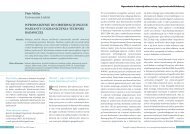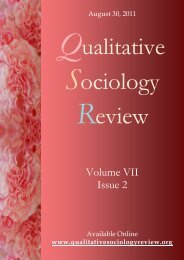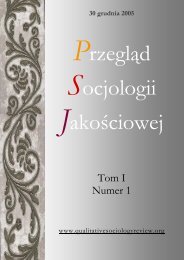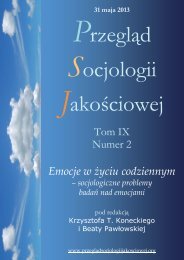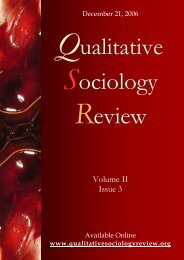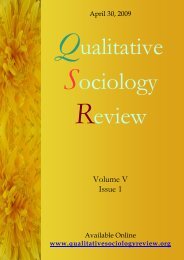Gillies, V. and Edwards, R. - Qualitative Sociology Review
Gillies, V. and Edwards, R. - Qualitative Sociology Review
Gillies, V. and Edwards, R. - Qualitative Sociology Review
Create successful ePaper yourself
Turn your PDF publications into a flip-book with our unique Google optimized e-Paper software.
£100,000. iv Her neighbours are mainly other highly educated professionals <strong>and</strong><br />
business owners, with ACORN describing her street as inhabited by the most affluent<br />
people in the UK. Katherine has lived the area for the past seven years <strong>and</strong> has no<br />
family members living nearby. She does not have a close relationship with her<br />
parents <strong>and</strong> has rarely asked them for help or support. Katherine’s husb<strong>and</strong> (a full<br />
time lawyer) takes the children at weekends.<br />
Katherine’s main support network is provided by friends, neighbours <strong>and</strong> work<br />
colleagues. She has a very good relationship with her neighbours <strong>and</strong> feels that she<br />
lives in a ”great community”. Most of Katherine’s neighbours have children of their<br />
own <strong>and</strong> they socialise regularly. Although Katherine’s employs a child minder three<br />
days a week her children spend a lot of time next door playing with the neighbours’<br />
children. Katherine has a close relationship with the female neighbours either side of<br />
her <strong>and</strong> feels they were particularly supportive when she was splitting up with her<br />
husb<strong>and</strong>. Katherine also feels her work colleagues are an important source of<br />
support, <strong>and</strong> mentions a particularly good friend in her workplace. She regularly<br />
holidays with this friend <strong>and</strong> her neighbours. Katherine is also involved with the<br />
school’s Parent Teachers Association <strong>and</strong> as a result has built relationships her<br />
daughters’ teachers <strong>and</strong> other local parents.<br />
According to Coleman, both Julie <strong>and</strong> Katherine exhibit the characteristics of<br />
low social capital, with their lone parenthood reflecting ”the most prominent element<br />
of structural deficiency in modern families” (1988: 111). He argues that lone parented<br />
children are inevitably under supported <strong>and</strong> are as such more likely to engage in<br />
delinquent behaviour. In contrast, families with high social capital are seen by<br />
Coleman as re-enforcing pro-social values through the development of an<br />
intergenerational bond that socialises children into relationships characterised by<br />
mutual trust <strong>and</strong> obligation. Such deficits are not identifiable in our case study<br />
examples, with both mothers <strong>and</strong> their children socially embedded as active<br />
members of their communities, sharing strong values around mutual responsibility<br />
<strong>and</strong> obligation.<br />
Julie <strong>and</strong> Katherine are clearly both well networked, but the social capital they<br />
rely on <strong>and</strong> access on a daily basis is rooted in their very different social <strong>and</strong><br />
economic circumstances. Julie struggles to make ends meet on welfare benefits, but<br />
far from encouraging a relinquishment of personal responsibility (as Coleman<br />
alleges) her life as a lone mother is sustained through highly reciprocal supportive<br />
relationships. In contrast, Katherine’s financial independence enables her to combine<br />
social relationships with paid for services to secure any help she needs. As well as<br />
employing a childminder three days <strong>and</strong> one evening a week, Katherine also pays for<br />
the children to attend regular after school activities such as French, chess <strong>and</strong><br />
swimming. Although she has less need of informal support she benefits on a<br />
personal <strong>and</strong> emotional level from maintaining reciprocal relationships with<br />
neighbours, friends <strong>and</strong> other mothers. Significantly, through creating <strong>and</strong><br />
maintaining these links, Katherine is able to access influential networks that Julie<br />
would most likely be excluded from.<br />
Differences are also apparent in terms of the value <strong>and</strong> meaning of the social<br />
resources each mother provides <strong>and</strong> acquires. Julie has time <strong>and</strong> experience of<br />
raising children <strong>and</strong> is able to provide invaluable childcare help to her sister <strong>and</strong> other<br />
friends. In return, Julie’s shopping is often collected <strong>and</strong> bought for her, while the<br />
goodwill she generates st<strong>and</strong>s as potential future resource if practical or financial<br />
help is needed. As a result Julie’s social capital is in the main converted to the<br />
practical help <strong>and</strong> psychological support that enable day to day survival. For Julie,<br />
this is experienced in terms of strong emotional bonds with particular individuals, <strong>and</strong><br />
is expressed as a form of familial interdependency. Like many other working class<br />
©2006 QSR Volume II Issue 2 www.qualitativesociologyreview.org 48



